
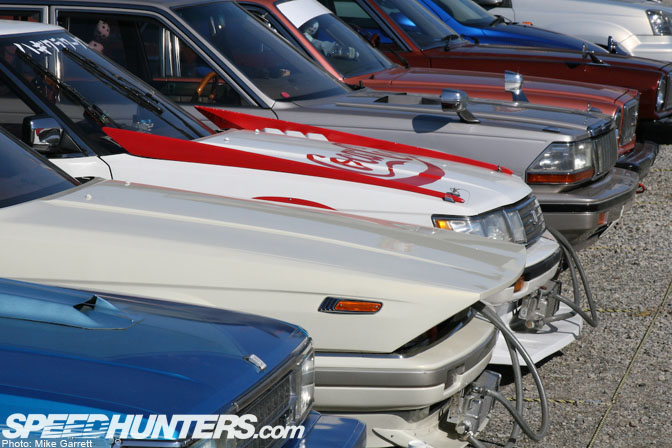
Earlier this month, I looked a little bit at the Japanese classic car scene and discussed some of the popular models and different styles of classic car restoration and modification in Japan. One thing that I didn’t really touch upon in that post was the “kyusha kai” culture that can be found all over Japan. There are different names that have been used for these cars and sometimes they are known as “bosozoku” or “yanki” cars, but in actuality those names don’t really fit too well. Or at least they don’t anymore. You probably know about the infamous bosozoku motorcycle gangs and how they are known for riding around revving their engines in the middle of the night and causing other sorts of trouble. While it is true that some bosozoku members drive or drove cars like this, the majority of the people that have these cars today are just car enthusiasts who enjoy the style. It is for this reason that they prefer to labeled as kyusha kai or quite simply, classic car group. They mostly do this in order to separate themselves from trouble making bosozoku who have a less than good reputation among the Japanese public. So to call everyone that drives around in one of these cars a bosozoku is kind of like calling anyone who rides a Harley Davidson a Hell’s Angel.
Even within the kyu-sha world, there are a number different styles and they range from mild street cars to extravagant builds where you can’t even tell the original model of the car. These cars take their styling inspiration from a number of different places and it can be quite interesting trying to discern their origins and the differences between them.
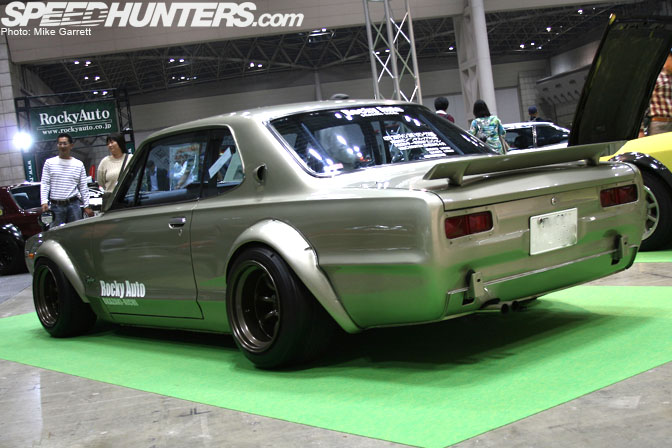
One of the earlier, and probably my favorite style of classic car modification is seen above on the Hakosuka Skyline from Rocky Auto. If I am not mistaken, this style is sometimes referred to as “Works” style, and as you can see, it draws a lot of inspiration from the early race cars that ran in series like the JAF Japan Championship. Unlike some of the other styles, most of these cars are still tuned with performance in mind. The bumpers are removed, the stance is low, and the fender flares are aggressive, but not too over the top. This style is generally restricted to sports car models like the Skyline, Z, etc.
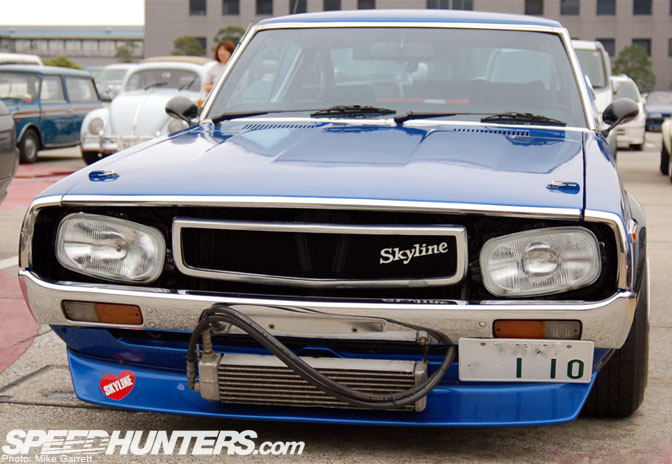
This 110 Nissan “Kenmeri” Skyline is done in a similar style. The external oil coolers are a replication of the early race cars, and it is a styling element that has generally stuck around among classic car modifiers. The stock lighting on this car consists of four round headlights, but on this car they have been replaced with two one-peice lights which were angled down for a more intimidating look.
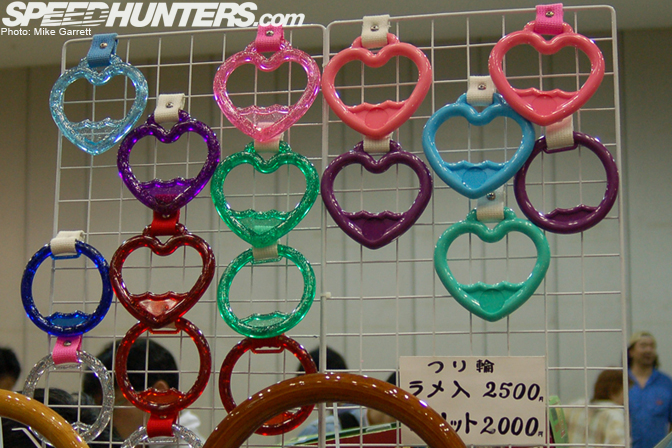
On a lot of these modified street cars, you will see something hooked to the rear bumper which drags along the ground as the car drives. After all,that’s how you prove how low your car is, right? Originally people used passenger handles from trains and subways, but now you can buy specially made ones that come in all sorts of colors and even in different shapes. These can be seen on all sorts of modified kyu-sha on both the rear bumpers and sometimes inside the cars as well.
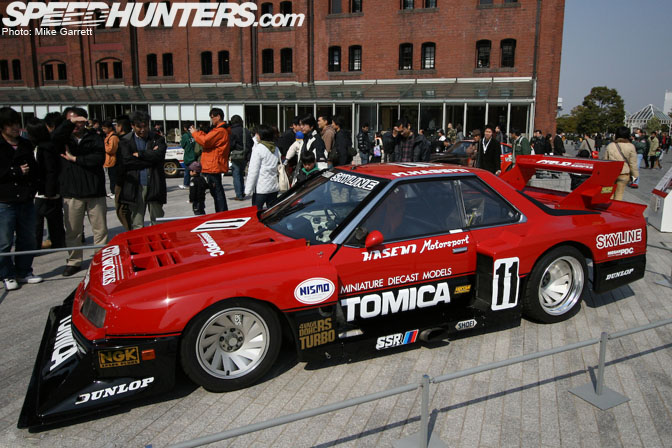
In the early 1980’s, the short-lived Super Silhouette race cars made a huge impression on car enthusiast with their extreme aero parts. It wasn’t long until this sort of styling began to appear on street cars. Of course there were no companies that made kits for this stuff, so a lot of the parts were one-offed. Eventually some of the street cars would be sporting body work that made the original Super Silhouette cars look tame in comparison.
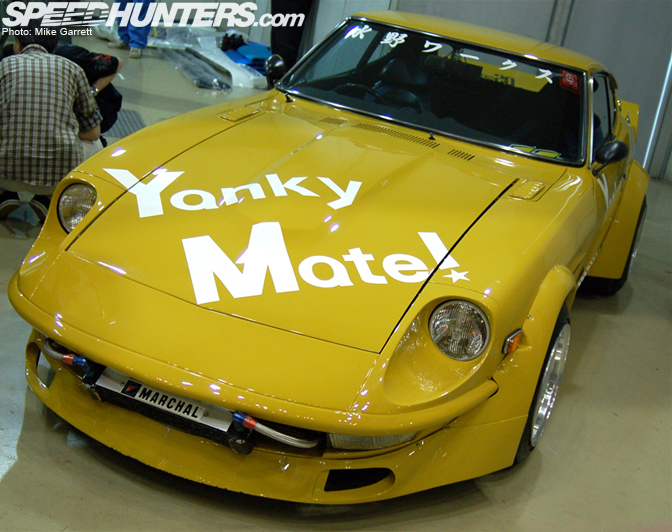
Also In the mid 1980’s, there was a movie released in Japan called “Shakotan Boogie”. It followed two young guys who spend their time cruising around in their fixed up cars and picking up chicks. Kind of like a Japanese American Graffiti. Although the movie is not well known by the general public, it still is a cult classic among kyusha fans to this day. The yellow S30Z in the photo above is a replica of the Z featured in the movie, complete with its “Yanky Mate!” graphics. After the movie, Shakotan Boogie also became a manga series written by the same guy who does Wangan Midnight. The cars in the movie featured the super long protruding exhaust pipes that are common on some of these cars. I am not exactly sure where that trend was derived from, but it is another signature of the more extravagant builds.

Sedans soon became popular among the kyusha crowd and the Toyota GX71 chassis in particular is a big. I suppose that the popularity of the early model Mark II’s and Crestas might have had something to do with the popularity of the JZX chassis later on. Generally, these sedans seem retain stock engines and are modified mostly for looks. I have seen a few with some pretty wild engine swaps though. As I mentioned in my post about VIP style, I think that a lot of the roots of VIP can also be found in these cars. I guess you could say the same for drift car style when you see the stretched tires and negative camber.
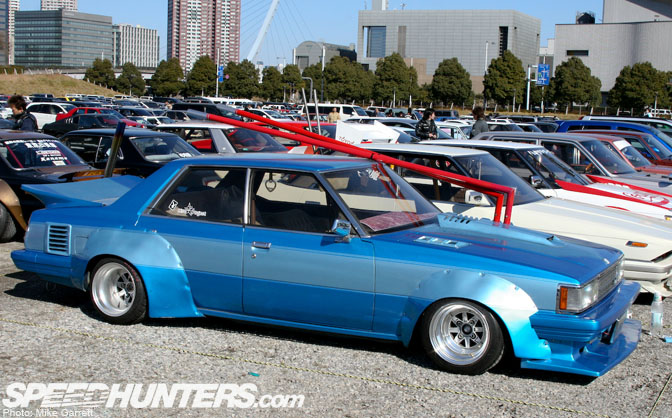
This car’s wild body and paint work are common of the more extravagant cars. I guess you could say that these cars are the Japanese equivalents of the chopped and slammed Mercurys that were found in states back in the 1950’s. I guess the “bubble period” Japanese 1980’s mirror the American ’50s in a lot of ways. Economic prosperity, a touch of counterculture, and hot rods. Seeing these cars must evoke a lot of nostalgia among people who were around during that period.
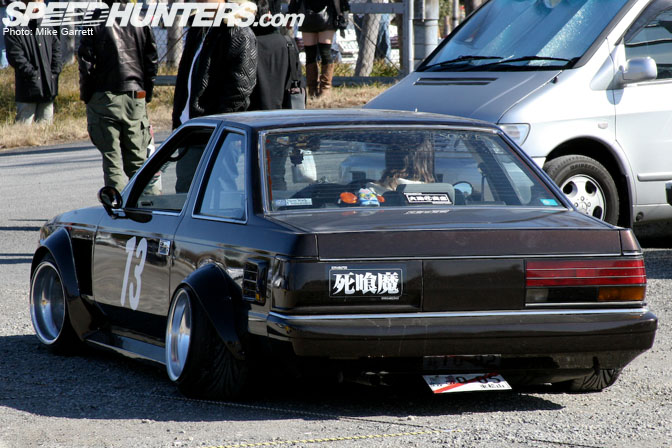
Although slightly more subtle than the car in the previous photo, this Z10 Toyota Soarer is still plenty aggressive. A lot of the car and bike clubs had their own stickers and I’m sure that this sort of thing helped to inspire the idea of modern day drift team stickers. Just look at the fender flares that cover up this car’s SSR Mk1 wheels. In a lot of cases, the wheels on these car are nearly as wide as they are tall!
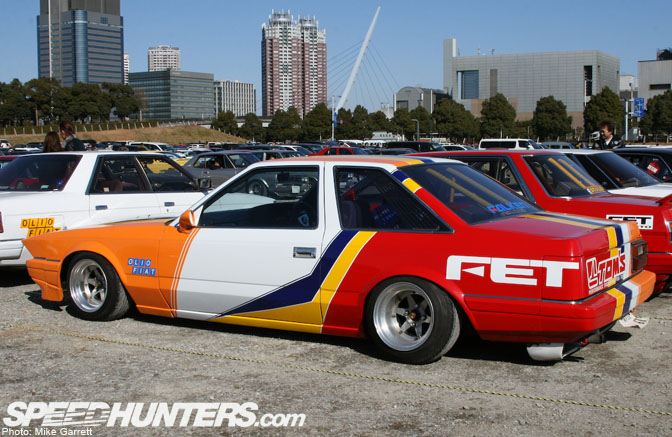
Here is another Z10 Soarer. This one has a race car-inspired pain tjob as well as a “long nose” or “shark nose” conversion which were done to give the front end of the car a more angular and menacing look. The Z10 was/is a popular platform for this sort of a modification and one of the main characters in Shakotan Boogie drives a blue and white Soarer with polka dots all over it.
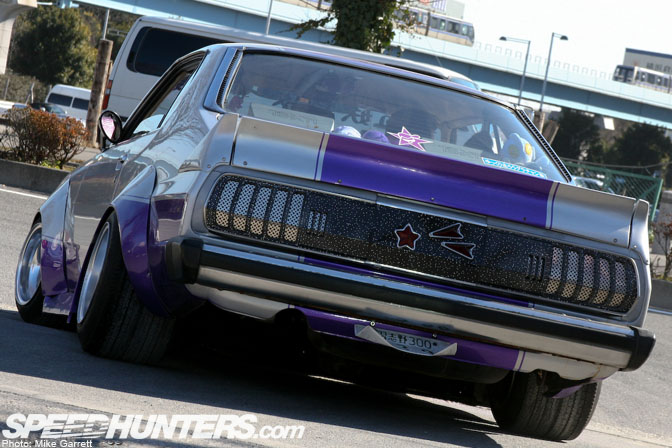
The GC210 “Japan” Skyline is another popular platform. This car has all the standard stuff, wide, dished wheels with big flares and plenty of custom paint and body work. In fact this particular car doesn’t even look a Skyline from the rear view. The famous round tailights are gone and in their place is a complete rear panel from a Toyota Celica liftback, which happens to draw its inspiration from an early Mustang fastback. Also check out the custom star-shaped light and flaked paint.
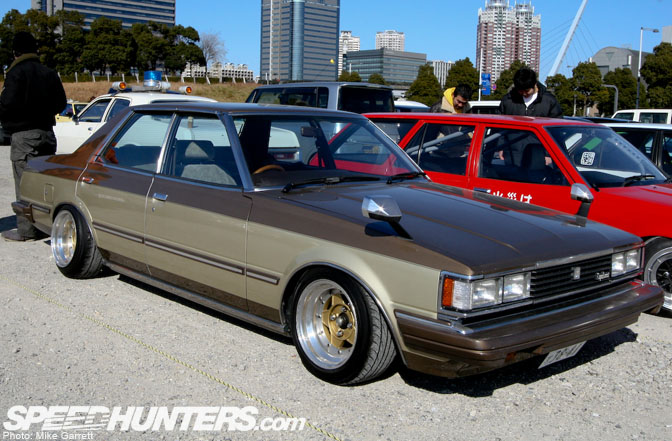
Some people skip the crazy body modifications altogether and just throw on a set of aggressive wheels and make the car sit as low as they can. This style works well in my opinion and obviously it allows you to cruise around with attracting too much attention from the law. Although “Shakotan” literally translates to “low car”, cars with subtle body modifications but a low ride height and aggressive wheels are sometimes referred to as Shakotan style.
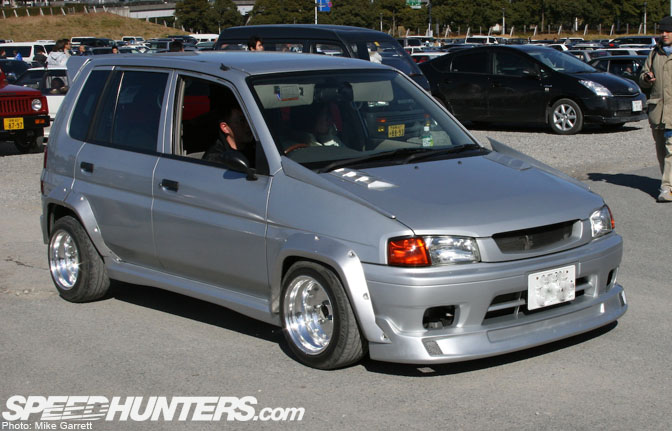
Lastly, you have to ask whether a car needs to be a “classic” in ordered to fit in amongst the kyusha crowd. Although this Mazda Demio was built in the 1990’s, it has been modified in an old school style. Custom overfenders, low offset SSR Mk.1’s, and even the custom fins and vents on the hood. It is actually fairly common to see late model compacts and kei cars done up in this style. Maybe this is his daily driver while the “real” classic is saved for special occasions?
Hopefully that sheds a little light on the subject. If you looking for some additional info, my friend David at Retro Scene Magazine also did a post while back which further clarifies some of the difference in Japanese classic car styles.
-Mike Garrett








That GX61 markII is one awsome ride.
that was just amazing! I've never heard of this style! you guys really makes any car enthusiast wannabe to bow! you guys have the best blog in the world! you know what your talking, and take the car world to another level!, the pictures are amazing too
congratulations!
great post man, but I think I'll keep calling them "bosozoku"
awesome! i've always had a huge passion for cars of the violent-running variety
there's a large thread on the VWVortex from years ago which is just pictures from a kyusha meet in the Daikoku Futo parking lot, such classics! including the yellow Z above, or one with a suspiciously similar oil-cooler setup ;D
amazing articles as always Mr. Garrett! cheers
here are some links
big thread on Cali-Boso: http://forums.motivemag.com/zerothread?cmd=print&id=3824405
Cali-Boso enthusiast: http://violentrunning.squidd.org/
the vortex thread: http://forums.vwvortex.com/zerothread?id=1364258
.
.
.
THE resource for vintage kyusha style pictures:
http://tanetane92.web.infoseek.co.jp/
(click on "gallery" on the left frame, scroll down and look especially at the older sets, like Nagoya Performance Car shows)
Thanks for the link up Mike nice write up and good to see this info getting to a wider audience.
nice write up and good to see this info getting to a wider audience.
 .. Kyusha-kai is "Classic Car Group" .. so these are styles that people apply to kyusha cars, but Kyusha isn't a style in and of itself
.. Kyusha-kai is "Classic Car Group" .. so these are styles that people apply to kyusha cars, but Kyusha isn't a style in and of itself  ...
...

Just to add/clarify Kyusha simply means 'classic car'
There are some great Shakotan cars here :
http://www.asahi-net.or.jp/~kf2m-isbs/gyakusyu.htm
And you can read our write up about the original VWVortex thread here :
http://www.retroscenemag.com/post/How-one-discussion-thread-changed-the-world.aspx
Yay! For bonkers japanese cars
theres a group of poor 20 year old none-asians in socal tryin to copy this style on thier cars ad they get offended on the forums when u dis it lol.
good post thanks for the info
someone posted a link to vrt as cali style... those guys i think would be a disgrace to mimmic. their style doesnt even flow right, they are just poor and cant afford better stuff so they copy this lol
I love those Bousouzoku Style japanese cars!
I still remember some outlow guys were living behind my house when I was a little child.
Some day I hit their car, I guess it was Nissan Laurel or something, with my tricycle (lol).
I cried not because I hurt but was so scared of the owner of the car and other guys hanging out there because I knew they were Bousouzoku.
But nex moment the owner and his friends helped and asked me if I got injured, and they didn't care if the car got scraches or dents.
I understood car enthusiasts are really good people, and that's one thing I love car guys.
By the way, I love GX 71s best!
You introduced this style to me on auto-otaku but it still never ceases to amaze me. Thanks Mike
I do like the Shakotan aka Bosozoku etc. Doing it in the states though it has to be done only to a certain degree. Once you get into the over the top outrageous territory ou will be considered a ricer(or othe words i will not type lol) by people who dont understand the car scene. Also you will be getting plenty of attention from cops when you driving down the highway and you exhaust is goin 3 feet vertically out of you car.
i cant belive no ones droped this site/fourm yet... its dedicated to this style
check it out.
very good write up.
http://www.auszoku.net... i should of wrote that in... sorry
where could we see some clips from the Shakotan Boogie movie? any links? i tried youtube but nothing came up.
[View:http://www.youtube.com/watch?v=6Mz018yf1-M&eurl] I think that perhaps all the Japanese car
nbed6D http://wvfvxgjzlxby.com/">wvfvxgjzlxby, [url=http://nsxcgheydkkd.com/nsxcgheydkkd/url], [link=http://jnmcfczsaasa.com/jnmcfczsaasa/link], http://baxgbbvixdrw.com/
Somehow I do prefer the Bosozoku desgnation of this style...